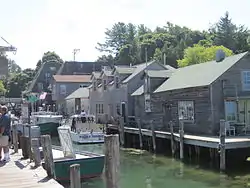Leland Historic District (Leland, Michigan)
The Leland Historic District, colloquially known as Fishtown, is a historic district roughly bounded by the park, Main Street, Avenue A, and the harbor, in Leland, Michigan. It was designated a Michigan State Historic Site in 1973[2] and listed on the National Register of Historic Places in 1975.[1]
Leland Historic District | |
 | |
  | |
| Location | Roughly bounded by the park, Main St., Ave. A, and the harbor, Leland, Michigan |
|---|---|
| Coordinates | 45°1′24″N 85°45′40″W |
| Area | 9 acres (3.6 ha) |
| NRHP reference No. | 75000951[1] |
| Significant dates | |
| Added to NRHP | November 20, 1975 |
| Designated MSHS | June 28, 1973[2] |
History
In 1853, Leland pioneer Antoine Manseau constructed a dam across the Carp River at this location.[2] Manseau built a sawmill and docks, setting up Leland as a wooding station for steamers.[3] By 1867, 200 people had settled in Leland. The area also began to develop a fishing fleet, with commercial increasing in importance from the 1870s through the 1890s.[4] More development followed, and in 1886 the county seat was moved to Leland.[5]
In the early 1900s, fishermen began enclosing their open boats and adding gasoline engines, which increased the scale of fishing operations.[4] By 1937, two breakwaters were constructed in the waters of Lake Michigan, which also facilitated the rise of the local fishing industry.[2] However, in the 1940s, the whitefish and trout populations in the lake were decimated by sea lampreys. Although commercial fishing operations continued, the area relied more heavily on tourism and charter operations. In the 21st century, the harbor area contains a mix of commercial fishing and tourist operations.[6]
Beginning in 2019 and intensifying in 2020, many of the historic shanties have become inundated with water on a regular basis due to record high waters in Lake Michigan and increased flow from the Carp river. The owner of the site, Fishtown Preservation, is raising funds to raise, repair, and stabilize the shanties and preserve current and future fishing operations. The first shanty to be moved, on January 10, 2020, was the Village Cheese shanty, with the Morris Shanty scheduled to be raised in the winter of 2020-21.[7]
Description
The Leland Historic District, containing both commercial and residential structures, is located at the mouth of the Carp River.[2] It encompasses one of Michigan's most scenic villages; the structures in the district are substantially original, with few alterations. The district includes Leland's commercial area, containing historic buildings, the fishing shanties, smokehouses, and docks in the outlet of the river[4]
References
- "National Register Information System". National Register of Historic Places. National Park Service. July 9, 2010.
- "Leland Historic District". Michigan State Housing Development Authority: Historic Sites Online. Archived from the original on February 21, 2014. Retrieved February 7, 2014.
- "A brief history of Leland..." Leland, MI. Archived from the original on February 22, 2014. Retrieved February 7, 2014.
- "Fishtown (Leland, Michigan)". Fishtown Preservation. Retrieved February 7, 2014.
- "Welcome to the Leelanau Township Website". Leelenau Township. Retrieved February 7, 2014.
- "Fishtown". Leland. Retrieved February 7, 2014.
- Holmes, Amanda (17 January 2020). "Fishtown's Village Cheese Shanty Is Now Safe" (PDF). Fishtown Preservation Society. Retrieved 19 June 2020.
External links
| Wikimedia Commons has media related to Leland Historic District (Michigan). |
